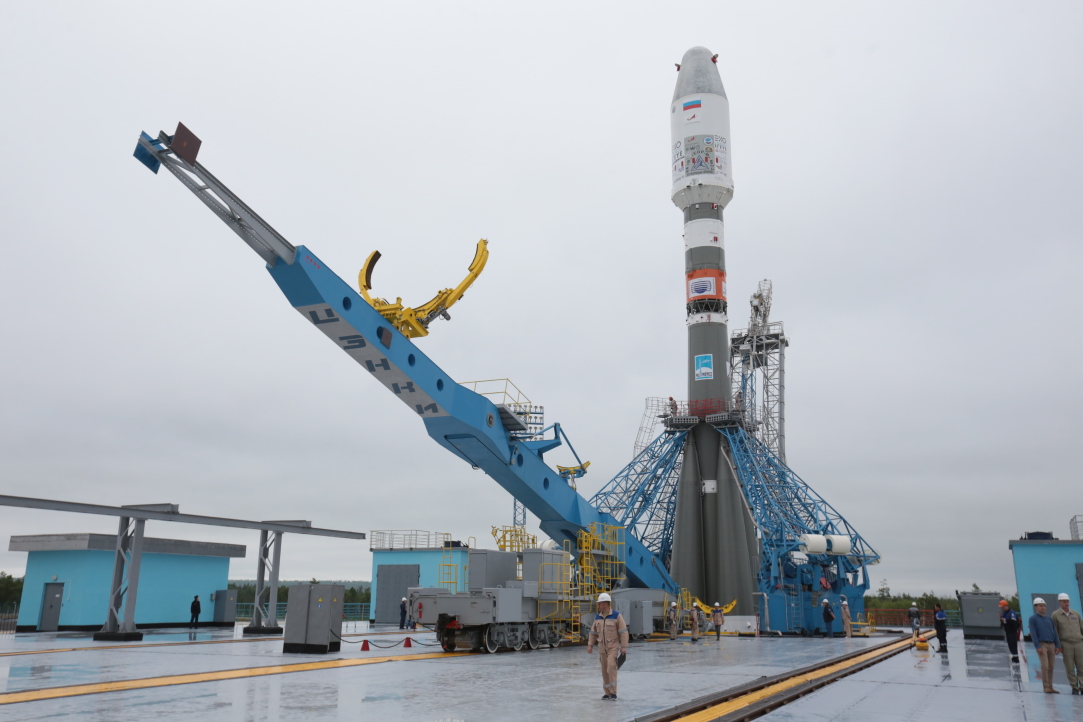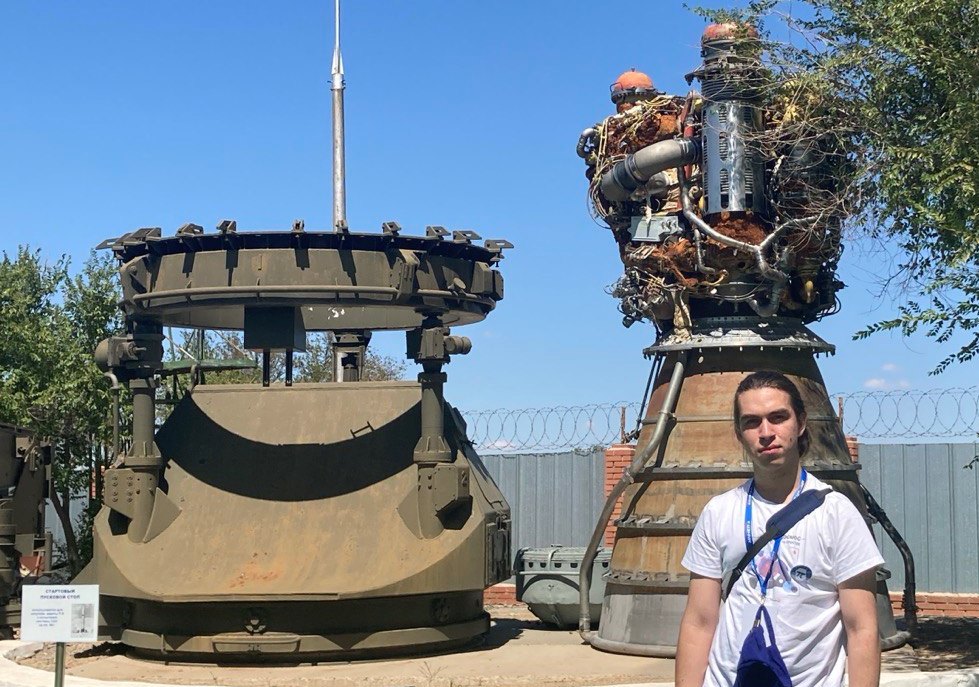Second HSE University Satellite Launched from Baikonur

On August 9, a Soyuz 2.1b rocket launched with a payload of HSE University’s second satellite, which will monitor the land surface of the Arctic region. HSE MIEM Deputy Director Andrey Abrameshin spoke about the university’s space plans, while Vyshiy Pilotazh competition winner Alexey Gilenko shared his impressions of the launch at Baikonur Cosmodrome.
The CubeSat satellite, which will become part of a system for tracking the movement of ships along the Northern Sea Route, has successfully entered orbit. ‘The devices have left the container and we have received the first signal that the whole system is working,’ said Andrey Abrameshin. He added that the tasks for the coming month are to activate and test the on-board computer and commands: ‘Once we fine-tune everything and stabilise the orbit, we will start working with the payload.’
The main task facing the developers of the spacecraft is to facilitate continuous and stable signal reception from ships to the satellite and from the satellite to a ground station. ‘This is difficult to do today,’ explains Andrey Abrameshin. ‘A ship can only transmit a signal to a ground station within direct line of sight. Our goal is to create and maintain an interactive map of the locations of ships in the Arctic region.’
The second major task is to determine the thickness of the ice in the region—more CubeSat satellites will be launched in the next three years to achieve this.
Andrey Abrameshin notes that the next launch is scheduled for March 23, when 24 spacecraft will be sent into orbit to expand the satellite constellation. Over the next six months, the HSE University team will work with Roscosmos to prepare and conduct trials of the new spacecraft, taking into account the shortcomings of those that have already been launched.
Andrey Abrameshin, Deputy Director of HSE MIEM

Two years ago, HSE University started to engage school students in formatting the main platform and improving the ‘brain’ of the satellite’s on-board computer. The students got involved actively and enthusiastically, learning to execute and transmit service commands to control the spacecraft and stabilise its orbit. We already rely on this major collaboration. On April 12, Deputy Mayor of Moscow for Social Development Anastasia Rakova announced that the Moscow government will support an initiative of HSE University and Roscosmos to introduce space classes to Moscow’s schools. HSE University, MIREA, and MAI will be the leading educational and methodological platforms of this project under the guidance of Roscosmos.
Alexey Gilenko is an eleventh-grade student at Moscow School No. 1363. He has won the Top Class competition in the category of ‘Satellite Construction and Geoinformation Technologies: Terra Notum’ and the Aerospace category of the Moscow Pre-Professional Olympiad. Alexey was awarded for his active part in the development of the HSE University satellites with a trip to the Baikonur Cosmodrome.
Alexey Gilenko

How it all started
When I was in the ninth grade, I decided to take part in the Top Class competition. At the time, I didn’t have any particular skills in this field, but I felt like I could be successful. I got help with the project from an HSE University-appointed mentor. I didn’t know much about spacecraft and I decided to make a model—a prototype satellite in the format of CubeSat-1U. Satellite construction is one of the categories in the Vyshiy Pilotazh competition, and I wanted to try out my abilities and copy several main systems: the power supply, communications, etc. I won the competition with this project, earning 95 points out of 100.
The same year, I won in the Aerospace category of the Moscow Pre-Professional Olympiad run by HSE MIEM. I took part in the Top Class competition again in the tenth grade. I worked specifically with the satellite’s power system and was awarded 100 points. I also took part in the Pre-Professional Olympiad again and won. And as a result, I got to go to Baikonur!
The cosmodrome and the launch
The feeling of being at Baikonur is indescribable! When I got off the plane, I saw such a beautiful sky. We had a lot of tours of the cosmodrome buildings that aren’t used for launches anymore—people aren’t allowed into the active ones. The emotions during the launch itself were wild! We watched from a distance of five kilometres, but it felt like everything was happening right in front of us.
It goes without saying that my future speciality will be related to engineering sciences. I will be going to university in a year, and HSE University is at the top of my list. I plan to study Information Science and Computation Technology at HSE MIEM, as this programme is the closest to my interests.
See also:
HSE University Satellites: Three Years in Orbit
In March 2024, HSE University celebrated an important milestone — the third anniversary of the successful operation in orbit of its first CubeSX-HSE and CubeSX-Sirius-HSE satellites. These spacecraft, created on the basis of the CubeSat platform for Earth observation, continue to function actively, confirming high technological standards and reliability of the university's developments.
‘We Control the Flight of Small Spacecraft’: How HSE University Launches Satellites
Following the meeting with participants of the 3rd Young Scientists Congress, Russian President Vladimir Putin assigned the government to include the creation and launch of small spacecraft in a new national project. Universities will also be involved in the project. Dmitrii Abrameshin, Head of the Mission Control Centre at the Moscow Institute of Electronics and Mathematics at HSE University, spoke about the mechanism of small satellites and which satellites have already been launched by HSE University.
HSE University’s Third Satellite Launched from Vostochny Cosmodrome
The small CubeSX-HSE-3 spacecraft was created by students and staff of the HSE Tikhonov Moscow Institute of Electronics and Mathematics. It is based on the OrbiCraft-Pro 3U platform by Sputnix. The work was carried out as part of the Space-π project with support from the Innovation Support Fund.
In Space with MIEM: All Systems Go!
On April 12th, the traditional Big Space Break took place at the HSE MIEM. This interactive event for students and staff was organized by specialists from the Laboratory of Space Vehicles and Systems' Functional Safety.
HSE University’s First Satellite Travels 478.7 Million km
The satellite entered orbit two years ago. The launch of the Soyuz-2.1a rocket with a Fregat upper stage and 38 satellites on board, including CubeSX-HSE, took place on March 22, 2021 at the Baikonur Cosmodrome.
HSE University Is Preparing to Launch its Second Satellite into Space
Only one year ago, the first HSE University satellite, developed by specialists and students from the Laboratory of Space Vehicles and Systems’ Functional Safety of the HSE Tikhonov Moscow Institute of Electronics and Mathematics (MIEM HSE) and the Sputnix space company, was launched into orbit. And now, the date of the second HSE University’s satellite launch has been announced: Roscosmos will send it into space from Baikonur Cosmodrome on August 9th, 2022.
240 Million Kilometres: HSE Satellite Spends a Year in Orbit
A year ago, on March 22, 2021, at 9:07 Moscow time, a Soyuz-2.1a rocket with a Fregat upper stage was successfully launched from Baikonur Cosmodrome Site 31. The launch vehicle carried 38 satellites, including the CubeSX-HSE satellite developed through the joint efforts of experts and students from the HSE University Laboratory of Space Vehicles and Systems’ Functional Safety of the HSE Tikhonov Moscow Institute of Electronics and Mathematics (HSE MIEM) and Sputnix, a privately-owned space company.
HSE University Participates in Satellite Navigation Monitoring Project
A team of HSE students is taking part in the development of a Russian satellite automatic identification system (AIS) to monitor sea navigation. The aim of the project is to track the locations of vessels and adjust their routes, including in the Arctic along the Northern Sea Route.
‘The Trip to Baikonur Blew My Mind!’
On Cosmonautics Day, the HSE News Service spoke with the participants of the CubSX-HSE project, which recently launched a satellite into Earth orbit. Students and staff from the HSE Moscow Institute of Electronics and Mathematics (MIEM) spoke about their project and impressions of their trip to Baikonur.
HSE University’s CubeSX-HSE Satellite Launched into Orbit
On March 22 at 9:07 Moscow time, a Soyuz-2.1a rocket with a Fregat upper stage was successfully launched. The launch vehicle carried a total of 38 satellites from 18 countries into sun-synchronous orbits, including HSE University’s CubeSX-HSE satellite, which will conduct remote sensing of the Earth.


